How Much Coffee Should You Put in a Filter?
The most important part of brewing good coffee is the coffee-to-water ratio. This ratio decides how strong and tasty your coffee will be. But words like "scoops" and "cups" can be confusing, so this guide will make it simple.
Coffee and Water Ratios Explained
A brew ratio is just a simple recipe for how much coffee and water to use. It's written out using weight, like grams. This helps you get the right flavor and strength from your coffee grounds every time.
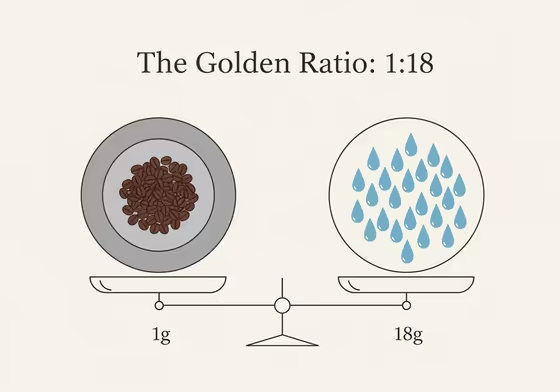
What is the "Golden Ratio" for Coffee?
The Specialty Coffee Association (SCA) suggests a "golden ratio" of 1:18. This means you use 1 gram of coffee for every 18 grams of water.
This ratio was made for professional coffee brewers. It aims for a specific strength and flavor that the SCA calls a "Golden Cup."
But this is just a technical standard, not a rule for how coffee has to taste. Many people find coffee made this way is a little weak. That's why lots of cafes use stronger ratios like 1:15 or 1:17 to get more body.
The Best Ratios for Drip Coffee
There isn't one perfect ratio, but there is a good range to stay in. For drip or pour-over coffee, that range is usually between 1:15 and 1:18.
- 1:18: This is the SCA standard. It makes a milder, lighter-bodied cup of coffee.
- 1:17: This is a common starting point. It's great for most coffee makers.
- 1:16: A popular middle ground that's easy for beginners using a scale.
- 1:15: Use this for a stronger pot of coffee with more flavor.
Filter coffee works by having hot water flow over the grounds. This is different from a French Press, where the grounds just sit in the water. Because of this, filter coffee usually needs less coffee than methods like a French Press.
A Simple Ratio for Beginners
If you're just starting, you have two options: easy or precise.
- The Easy Way: Use 1 to 2 tablespoons of ground coffee for every 6 ounces of water. Two tablespoons is a common choice for a full-flavored cup.
- The Precise Way: Use a scale and a 1:16 or 1:17 ratio. A simple recipe is 60 grams of coffee for 1 liter of water.
It's easy to just use scoops and spoons, but they can be inconsistent. The amount of coffee in a tablespoon changes based on the bean's roast and how fine it's ground. A scoop isn't a real unit of measurement.
So, the best tool for a beginner is a simple digital kitchen scale. A scale takes out all the guesswork. It makes your coffee-to-water ratio reliable every single time.
Finding the Right Ratio for You
The best ratio is the one you like the most. Here’s a simple way to figure that out.
- Start with a Baseline: A 1:16 ratio is a great place to start. For a 12-ounce mug (about 350 grams of water), that means using about 22 grams of coffee.
- Brew and Taste: Make the coffee and try it. If it tastes weak or sour, it's under-extracted. If it tastes bitter or harsh, it's over-extracted.
-
Adjust the Ratio:
- If it's too weak: Use more coffee next time. Try a stronger ratio, like 1:15. This will give it more body.
- If it's too bitter: Use less coffee. Try a weaker ratio, like 1:17. This will make a lighter cup.
- Repeat and Record: Keep trying new things, but only change one thing at a time. Write down what you like.
How to Measure Your Coffee
So, how much coffee do you actually put in the filter? It depends on how much coffee you want to make and the ratio you choose.
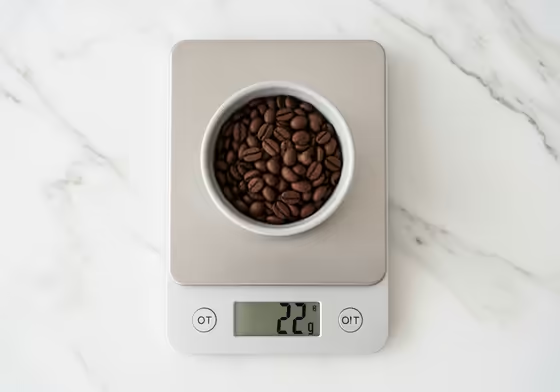
Here's the simple math: (Total Water in grams) / (Your Ratio Number) = Coffee in grams
For example, if you want to make 750 grams of coffee with a 1:17 ratio, you would do 750 divided by 17. That equals about 44 grams of coffee.
This table shows you exactly how much coffee to use in grams for common brew sizes.
Table 1: Coffee Dose (in Grams) for Common Brew Sizes and Ratios
| Brew Size (Water) | Approx. Mug Size | 1:15 Ratio (Strong) | 1:16 Ratio (Balanced) | 1:17 Ratio (SCA Start) | 1:18 Ratio (SCA Mild) |
|---|---|---|---|---|---|
| 240g / 240ml | 1 x 8 oz cup | 16.0g | 15.0g | 14.1g | 13.3g |
| 350g / 350ml | 1 x 12 oz mug | 23.3g | 21.9g | 20.6g | 19.4g |
| 500g / 500ml | 1 Large Mug / 2 small cups | 33.3g | 31.3g | 29.4g | 27.8g |
| 750g / 750ml | ~4 "Maker Cups" | 50.0g | 46.9g | 44.1g | 41.7g |
| 1000g / 1 Liter | ~5-6 "Maker Cups" | 66.7g | 62.5g | 58.8g | 55.6g (SCA) |
Using Scoops and Spoons
If you're using scoops, it helps to know what they mean.
- A "standard" coffee scoop is supposed to hold 2 level tablespoons.
- This usually equals about 10 to 12 grams of ground coffee.
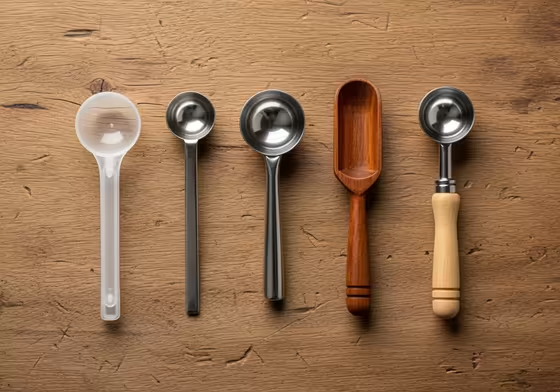
But be careful, because "standard" doesn't mean they are all the same. Coffee scoops come in different sizes, so the best thing to do is check your own scoop with a scale.
Just put a bowl on a digital scale, zero it out, and add one level scoop of your coffee. Now you know exactly how many grams your scoop holds.
How Much Coffee Per "Cup"?
This question is tricky because the word "cup" can mean three different things.
- The Coffee Maker "Cup": The lines on your coffee pot are not 8 ounces. They usually mean 5 or 6 ounces.
- A US Measuring Cup: This is a standard 8 fluid ounces.
- Your Drinking Mug: A normal coffee mug holds 10 to 16 ounces.
When a recipe says "per cup," it's talking about the 6-ounce coffee maker "cup."
- By Volume: The common rule is 1 to 2 tablespoons of coffee for every 6-ounce 'cup'. For a strong brew, use 2 tablespoons.
- By Weight: The standard is about 10 grams of coffee for every 6 ounces (180ml) of water. This gives you a 1:18 ratio.
- Is 2 tablespoons too much? No. For a 6-ounce coffee maker 'cup', 2 tablespoons (about 10-12g) is right. If your coffee is too strong, your grind is probably too fine.
- If you use just 2 tablespoons in a big 12-ounce mug, your coffee will be weak and watery. You would need about 4 tablespoons for a mug that size.
Coffee Amounts for Your Coffee Maker
Here's a quick guide for how much coffee to use in a standard coffee maker. All of these are based on the 6-ounce "cup" measurement.
Table 2: Quick Dosing Guide for Automatic Coffee Makers
| "Cups" on Maker | Approx. Water Volume | Quick Method (Scoops) | Quick Method (Tablespoons) | Precise Method (Grams) |
|---|---|---|---|---|
| 4 Cups | 24 oz / 720 ml | 4 Scoops | 8 Tbsp (1/2 cup) | 45 g |
| 6 Cups | 36 oz / 1080 ml | 6 Scoops | 12 Tbsp (3/4 cup) | 68 g |
| 8 Cups | 48 oz / 1440 ml | 8 Scoops | 16 Tbsp (1 cup) | 90 g |
| 10 Cups | 60 oz / 1800 ml | 10 Scoops | 20 Tbsp (1 1/4 cups) | 112 g |
| 12 Cups | 72 oz / 2160 ml | 12 Scoops | 24 Tbsp (1 1/2 cups) | 135 g |
| *Assumes 1 "standard" coffee scoop = 2 level tablespoons. | ||||
| ** Calculated using a 1:16 (grams coffee : grams water) ratio for a balanced, full-bodied brew. |
4 Cups
- For a 4-cup coffee maker (about 24 oz of water), use 45 grams of coffee.
- This is the same as 8 level tablespoons or 4 standard coffee scoops.
10 Cups
- For a 10-cup coffee maker (about 60 oz of water), use 10 standard coffee scoops.
- You can also use 20 level tablespoons, or 112 grams for a more exact brew.
12 Cups
- For a 12-cup coffee maker (about 72 oz of water), use 24 level tablespoons.
- This is about 12 coffee scoops. For the best pot, use 135 grams of coffee.
How to Use the Coffee Filter Correctly
Using the right amount of coffee is important. But how you use the filter matters a lot too.
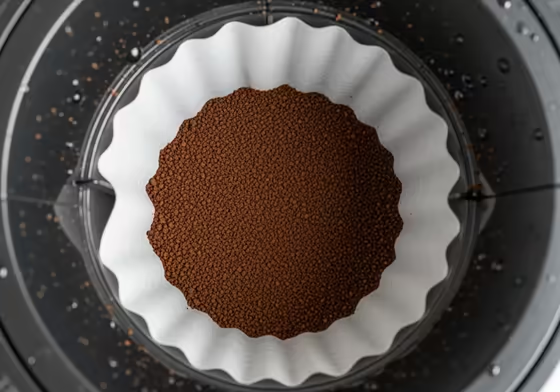
How Much to Fill a Coffee Filter
You shouldn't fill a coffee filter all the way to the top. Instead, you just add the right amount of coffee for the water you're using.
The dry coffee grounds should take up no more than half to two-thirds of the filter. This leaves room for the coffee to expand when it gets wet. It also helps prevent the filter from overflowing.
If your filter overflows, it's usually because the water can't get through. Here are the three main reasons why:
- Grind is Too Fine: This is the most common reason. If the coffee is ground too fine, like powder, it creates a muddy blockage. The fix is to use a medium grind, like the size of sea salt.
- Dose is Too Large: You simply put too much coffee in the basket. The fix is to use the right amount of coffee for your brew size.
- Filter Collapse: The paper filter can fold over and block the drain hole. To fix this, wet the filter with hot water before adding coffee grounds. This helps it stick to the basket walls.
Level Your Coffee Grounds, Don't Pack Them
After you put the coffee in the filter, make sure the grounds are flat and level. You can do this by gently tapping the side of the basket.
If the grounds are uneven, water will just flow through the thinnest part. This means some grounds get overused and taste bitter, while others get ignored and taste sour. Leveling the grounds helps the water flow through evenly for a balanced taste.
But you should never pack down the coffee in a drip machine or pour-over. This is called tamping.
- Tamping is only for espresso machines. They use high pressure to force water through the packed coffee.
- Drip coffee uses gravity. Tamping the grounds will create a block that water can't get through, causing an overflow.
Tips for Different Coffee Makers
Drip Coffee Maker
For a normal drip coffee maker, a good ratio is between 1:15 (for strong coffee) and 1:18 (for mild coffee).
- A good starting point is a 1:16 or 1:17 ratio.
- If you're using scoops, use 1 scoop (2 tablespoons) for every 6-ounce "cup" on your machine.
- If you're using a scale, use about 10-12 grams of coffee for every 180ml of water.
Here's a good tip: match your grind size to the shape of your filter. The filter's shape changes how deep the coffee bed is.

- For Flat-Bottom Filters: The coffee bed is wide and shallow. Use a medium grind (like sea salt).
- For Cone Filters: The coffee bed is deep and V-shaped. Use a finer grind (like granulated sugar) to slow the water down.
South Indian Filter Coffee
This method is very different from regular drip coffee. You brew a very strong coffee concentrate first. Then you add hot milk to it.
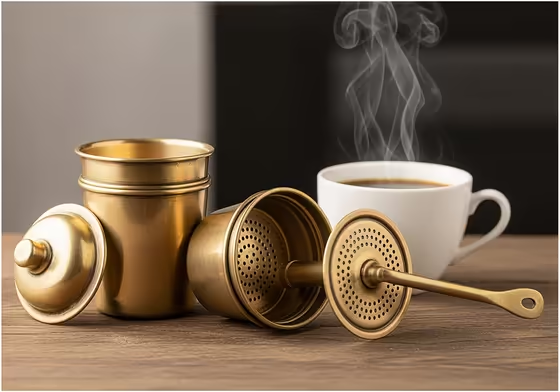
- The Ratio: The coffee-to-water ratio is very strong, around 1:4. A common recipe is 40g of coffee to 120ml of water.
- The Method: Add a few tablespoons of coffee to the filter. Press it down firmly with the plunger (this is very different from drip coffee). Pour hot water over it and let it slowly drip for 15-30 minutes.
- The Drink: You get a thick, strong coffee concentrate. You then mix this with hot milk, usually 1 part coffee to 3 or 4 parts milk.
What People Say Online
On websites like Reddit, you can see how people learn to brew coffee. It tells a pretty clear story.
- The Problem: New brewers are often confused by measuring with scoops and using old, pre-ground coffee. Their brews end up tasting both sour and bitter.
- The Solution: The number one tip people give is to buy a digital kitchen scale. Measuring by weight is the best way to get consistent results.
- The Go-To Ratio: The most recommended starting ratio for filter coffee is 1:16.
- Experimenting: From there, people adjust to their taste. They might use a 1:17 or 1:18 ratio for a lighter, tea-like cup. Or they might use a stronger 1:15 ratio for more body.
This shows the typical journey for making better coffee. You start with scoops, get frustrated, buy a scale, and start with a 1:16 ratio. After that, you can experiment to find what you like.
Key Takeaways
Making a great cup of filter coffee is all about controlling a few key things. The amount of coffee you use is the most important one to get right.
- Use a Scale: The best thing you can do for your coffee is to use a digital scale. Measuring in grams instead of scoops is the secret to making good coffee every time.
- Start with a Good Ratio: Don't just guess how much coffee to use. Start with a 1:16 ratio (that's 1 part coffee to 16 parts water). This is a great, balanced starting point.
- Know What a "Cup" Is: The "cup" lines on your coffee maker mean 6 ounces, not 8. The standard is 2 tablespoons (or 1 scoop) of coffee for each 6-ounce "cup."
-
Get Your Technique Right:
A perfect ratio won't save you from bad technique.
- Level, Don't Pack: Make sure the coffee grounds in your filter are level, but never pack them down. Tamping is only for espresso.
- Check Your Grind: If your filter overflows, your coffee grind is probably too fine.
- Wet Your Filter: Always rinse paper filters with hot water before adding coffee. This stops them from collapsing and gets rid of any paper taste.